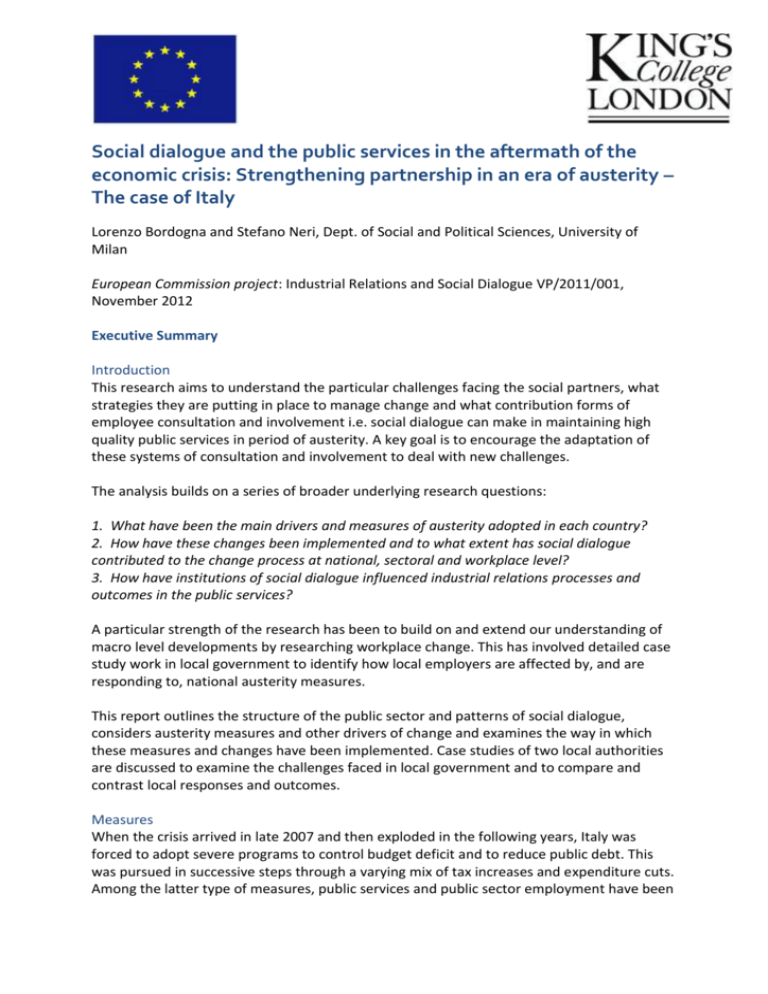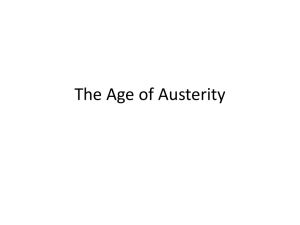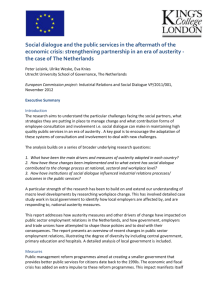Social dialogue and the public services in the aftermath of the
advertisement

Social dialogue and the public services in the aftermath of the economic crisis: Strengthening partnership in an era of austerity – The case of Italy Lorenzo Bordogna and Stefano Neri, Dept. of Social and Political Sciences, University of Milan European Commission project: Industrial Relations and Social Dialogue VP/2011/001, November 2012 Executive Summary Introduction This research aims to understand the particular challenges facing the social partners, what strategies they are putting in place to manage change and what contribution forms of employee consultation and involvement i.e. social dialogue can make in maintaining high quality public services in period of austerity. A key goal is to encourage the adaptation of these systems of consultation and involvement to deal with new challenges. The analysis builds on a series of broader underlying research questions: 1. What have been the main drivers and measures of austerity adopted in each country? 2. How have these changes been implemented and to what extent has social dialogue contributed to the change process at national, sectoral and workplace level? 3. How have institutions of social dialogue influenced industrial relations processes and outcomes in the public services? A particular strength of the research has been to build on and extend our understanding of macro level developments by researching workplace change. This has involved detailed case study work in local government to identify how local employers are affected by, and are responding to, national austerity measures. This report outlines the structure of the public sector and patterns of social dialogue, considers austerity measures and other drivers of change and examines the way in which these measures and changes have been implemented. Case studies of two local authorities are discussed to examine the challenges faced in local government and to compare and contrast local responses and outcomes. Measures When the crisis arrived in late 2007 and then exploded in the following years, Italy was forced to adopt severe programs to control budget deficit and to reduce public debt. This was pursued in successive steps through a varying mix of tax increases and expenditure cuts. Among the latter type of measures, public services and public sector employment have been a crucial target of government policies: levels of employment, wage and salary increases, and pension systems have all been the object of repeated measures adopted by the government. Both the national experience and the two case studies indicate a trajectory from an initial stage in which simple quantitative measures are adopted, with short-term effects on employment levels, recruitment of new personnel, economic and career prospects of employees, to one in which deeper changes, with longer term effects on the re-organization of service provision are detectable. More specifically, the first of these austerity packages, presented in 2008 (decree law no 112/2008) contained measures to severely cut down the replacement ratio of both public sector managerial and non managerial staff, to set constraints and tighter controls on collective negotiations at decentralized level, with reduced resources, and to tackle the absenteeism of public employees. Following this first austerity package, public sector employment has repeatedly been a crucial target of government measures, in May 2010, July 2011, August 2011, December 2011 and finally in Summer 2012. Three main types of measures were adopted: provisions aimed at cutting down the number of public employees; reform of the pension system; provisions targeted at wages and salaries of public employees, that also implied a freeze of the 2010-2012 bargaining round at national industry level, later extended to 2014, and, de facto, also a freeze of decentralised, enterprise level wage negotiations. The second set of measures, adopted first in 2008 and then strengthened in 2010-11, focused on wages and salaries of public employees. Wage and salary growth was significantly slowed down in 2008-09 in comparison with the 2000-07 period, and substantially frozen since 2010until the end of 2013 or, possibly, 2014. The wide gap with the private sector wage and salary increases over the 2000-07 period was first significantly reduced, and then subsequently reversed in recent years. A number of other expenditures were also cut down to a certain percentage of the 2009 level, including expenditure for personnel training activities. Detailed spending review procedures have finally been revived and are currently under way. Together with the wage and salary freeze and the generalized turnover freeze, the aim is to stop the increase of, and then reduce, the wage bill and total expenditure of public administration. Finally, the pension system was reformed both for private and public sector employees, with some distinctive features in the latter case. Social Dialogue Most of the preceding measures have been unilaterally adopted by the government, without previous negotiations with trade unions and without searching for trade union consent; in some cases, explicitly against trade union protests. Thus, at national level social dialogue did not play any significant role in shaping austerity measures, which were adopted unilaterally by the government without trade union consultation. These measures, in turn, among other effects, froze the machinery of national sector-level collective bargaining for almost two bargaining rounds, and drastically reduced the resources for decentralized negotiations at 2 single employer level. In the Regions and territorial authorities subsector these effects have been further strengthened by the rules of the Internal Stability Pact. Overall, the role of social dialogue in shaping and implementing austerity packages has been on the whole limited, although with some differences between different levels. A distinction also needs to be drawn between institutions and practices. Social dialogue institutions have been partially changed by the Brunetta reform, not by austerity measures. What the crisis did was to freeze the practice of public sector social dialogue, even in its reformed configuration. However, there can be variations at local level, as the case studies in this report show. Local Government Another strong target of government policies have been the expenditures of the regional and local government authorities (Regions, municipalities, provinces). Despite a process of regional decentralization which goes back to the early 1970s and a reorganization of territorial autonomies in the early 1990s, reinforced by a constitutional reform in 2001, since 1998 the budget policies of these decentralized entities are constrained within the tight rules of the so called Internal Stability Pact (ISP), linked to the EU Stability and Growth Pact. Within this institutional framework, financial transfers from the centre to local authorities have been severely cut in recent years while at the same time local authorities’ expenditures have been subject to notably stricter rules than in the past. This gave often rise to strong tensions between central government and the associations of local authorities - occasionally creating the opportunity for alliances between these organizations and trade unions against central government policies. In effect, also this very important component of government austerity programs has severely affected, along with the provision of local public services, employment levels and working conditions for a significant proportion of public employees. The centrally imposed austerity measures on local government seem to promote a slow but deep change in the role played by the municipalities. This shift in the role played by the municipality in the organization and provision of public services already started in previous decades, but it is being accelerated and intensified as a consequence of austerity measures. As the case studies of the report show, the practice of reducing staff numbers and also progressively abandoning direct provision of welfare services are evident: In Modena, the final outcome, so far, seems to be a slowly changing role of municipalities in the area of social and education services, from direct provision to a role of service ‘commissioning’, with an apparently decreasing quality of service provided to citizens. An alternative solution to staff shortage problems, sponsored by the unions, would be a deeper bureaucratic restructuring of the municipality, based on processes of internal mobility and skill retraining, possibly to keep the entire service provision in-house. But managers and elected authorities of the municipality look sceptical on the efficacy of this solution, perhaps hoping to improve over time the capacity and performance of the municipality as ‘service commissioner’. . The municipality of Sesto seems to be on the verge of following a similar path towards a greater externalization of services, although with some delay and a less clear-cut line of development than in Modena, due also to the recent election of the new mayor which partly 3 paralyzed any wide-ranging decision. Although employment levels have been rather stable in recent years, in Sesto as well the problems brought about by the austerity measures create uncertainties and strains in the relationship between the municipality and the trade unions, which are to some extent more fragmented than in Modena. Overall, these outsourcing processes are making it hard to promote or maintain a cooperative social dialogue. In both cases traditional relationships between the municipality and trade unions were highly cooperative, but there are signs of change underway. The combined effect of institutional reform, national level austerity measures and Internal Stability Pact rules is to freeze the practice of social dialogue, or to make it ineffective, even where there were well established relationships, soundly based on tight relationships between centre-left oriented municipalities and strong trade unions dominated by the Cgil. Conclusion Did the crisis block or prompt structural reforms? Has it been business as usual, with just some window dressing? In the light of previous analysis, we can conclude it is certainly not business as usual, while the answer to the first question is more nuanced. The implementation of the Brunetta reform, that was adopted to some extent independently from the economic crisis, was frozen by government austerity measures a few months after its adoption especially in terms employment relations and collective bargaining at national level. But its effects are visible at decentralized level, by limiting the scope of negotiable matters and encouraging unilateralism in union-management relations even in contexts where there have been well developed traditions of social dialogue. In the municipal subsector, government austerity measures together with the tight rules of the Internal Stability Pact and the strengthened unilateral prerogatives given to the public employer have had significant effects. In particular it is encouraging acceleration of trends towards processes of externalization of activities and personnel, leading to a significant change in the role of municipalities in the provision of public services. If this trend continues, the municipalities will become more like commissioning organisations, in charge of planning, financing/purchasing and monitoring of services provided by other, private sector organisations. This shift in the role played by municipalities in the organization and provision of public services started in previous decades, but it is being accelerated and intensified as a consequence of austerity measures. Key sources/references Bach S., Bordogna L., Della Rocca G., Winchester D. (eds) (1999), Public Service Employment Relations in Europe. London: Routledge. Bordogna L. and Neri S. (2011), “Convergence towards an NPM programme or different models? Public service employment relations in Italy and France”, International Journal of Human Resource Management, 22, 11: 2311-2330. Dell’Aringa C. (2007), “Contrattazione collettiva e costo del lavoro”, in Dell’Aringa and Della Rocca (eds): 3-32. Dell’Aringa C. and Della Rocca G. (eds) (2007), Pubblici dipendenti: una nuova riforma?, Soveria Mannelli: Rubbettino. Kickert W. (2007), “Public Management Reforms in Countries with a Napoleonic State Model: France, Italy and Spain”, in Pollitt, van Thiel and Homburg (eds): 26-51. 4











